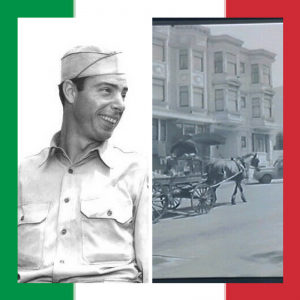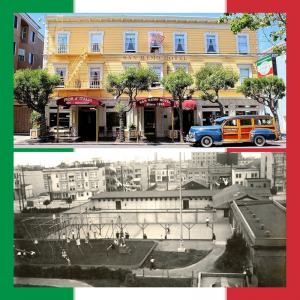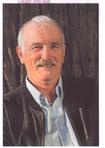John Michael McCarty's Blog, page 8
May 23, 2018
North Beach during W.W.II
North Beach during W.W.II saw the government classify thousands of Italian immigrants as “enemy aliens” after the Japanese attack on Pearl Harbor. Among those were Giuseppe and Rosalia DiMaggio. Each was required to carry photo ID booklets at all times and were not allowed to travel outside a five-mile radius from their home without a permit. Giuseppe’s fishing boat was seized and he was barred from San Francisco Bay.
Nevertheless, their son Joe, like most others, felt obligated to do their part. DiMaggio traded a $43,750 Yankees salary for a payment of $50 each month when he chose to enlist in the army on February 17th, 1943. Other sacrifices were made as well.
Sacrifices during W.W.II
Some citizens of North Beach utilized horse-drawn carts to save gas for the war effort. Teenagers, with their binoculars, manned two-story towers along the sand dunes of the Richmond District as well as atop Coit Tower on Telegraph Hill, scanning the skies for trouble. Lou Marcelli remembers his father fishing for shark. Its liver was prized by bomber pilots for improving night vision. Italian engineers and architects mobilized to help North Beach residents build bomb shelters in backyards. Citizens of the City donated 110 pints of blood a day to Red Cross. Others would make the ultimate sacrifice. Almost 1,900 San Franciscans would be killed in the line of duty before the war ended. The sight of black hearses at St. Peter and Paul’s Church became so common that Lawrence Ferlinghetti wrote a poem about it, about the old men sitting on a bench in Washington Square, watching.
The post North Beach during W.W.II appeared first on John McCarty.
May 19, 2018
North Beach During W.W.II
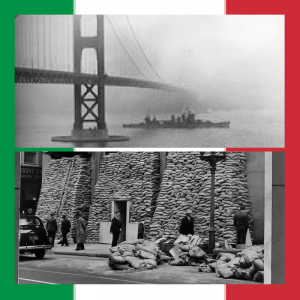 Like many U.S. citizens, the residents of North Beach during W.W.II feared the worst after the Japanese attack on Pearl Harbor, Dec. 7, 1941. The enemy had deployed their secret weapons (submarine aircraft carriers) along the West Coast to instill the perception that their Imperial Navy would continue the onslaught. The Western Command on December 8 received reports of enemy ships near the Farallon Islands. General William Ord Ryan of the Fourth Interceptor Command said a large number of unidentified aircraft were turned back at the Golden Gate. On Christmas Eve rumors spread that Japanese submarines were to surface and shell San Francisco with their 5.5-inch deck cannons. Less than twenty-four hours later, the headline of the Chronicle read “The Victim of a Jap Sub”. The American freighter Absaroka had been badly damaged with the lone fatality being a sixty-seven-year-old from North Beach, San Francisco.
Like many U.S. citizens, the residents of North Beach during W.W.II feared the worst after the Japanese attack on Pearl Harbor, Dec. 7, 1941. The enemy had deployed their secret weapons (submarine aircraft carriers) along the West Coast to instill the perception that their Imperial Navy would continue the onslaught. The Western Command on December 8 received reports of enemy ships near the Farallon Islands. General William Ord Ryan of the Fourth Interceptor Command said a large number of unidentified aircraft were turned back at the Golden Gate. On Christmas Eve rumors spread that Japanese submarines were to surface and shell San Francisco with their 5.5-inch deck cannons. Less than twenty-four hours later, the headline of the Chronicle read “The Victim of a Jap Sub”. The American freighter Absaroka had been badly damaged with the lone fatality being a sixty-seven-year-old from North Beach, San Francisco.
North Beach during the War:
Earlier that same morning on Christmas day, a convoy of camouflaged ships steamed under the Golden Gate carrying wounded evacuees from Pearl. Late weekday mornings in North Beach during the War, you could see a line of black hearses in front of St. Peter and Paul’s on Washington Square as bells tolled. Mourners would gather after the services at Original Joe’s to honor those that had served their country. Mayor Angelo Rossi declared a state of emergency. Civil Defense made blackout shades mandatory. Pete Curreri told the story of Block Wardens breaking down his father’s door on Green Street to enforce the regulation. Sandbags covered storefronts.
The post North Beach During W.W.II appeared first on John McCarty.
May 16, 2018
North Beach During the Depression
Optimism abounded in the North Beach District of San Francisco like so many other neighborhoods throughout the nation during the 1920s. It was a time of easy credit and installment buying. Until it wasn’t. On Black Tuesday, Oct. 29, 1929, the stock market crashed and sent everything spinning downward. Banks closed, credit dried up. The exuberant hurly-burly that was San Francisco stuttered to a crawl. It seemed everyone was out of work. There was not much meat but fish from nearby Fisherman’s Wharf was cheap. You ate a lot of soup as well— split pea, lentil, vegetable soup. Occasionally you might splurge and eat at Lucca’s restaurant on Powell and Francisco Streets in North Beach. It had a sign: “All you can eat for 50 cents.” Another local bargain was the San Remo Hotel (top photo), where you could order a Genoa-style full course dinner for less than a buck.
The Depression:
You sought distractions from the Depression in your Upper Grant flat like playing Monopoly or listening to the Philco radio, which ran on vacuum tubes and resembled the doorway of a medieval cathedral. Jack Benny or Fiber McGee and Molly might hold your interest for an hour before turning the dial to enjoy popular tunes of the day such as “Pennies from Heaven”, “Happy Days Are Here Again” and “We’re in the Money”. For a nickel (probably saved from your paper route or selling doughnuts door-to-door), you could venture down to the Palace Theater (later known as the Pagoda Palace) near Washington Square to watch You Can’t Take It With You or The Wizard of Oz. If you were really lucky, you might run into Joe DiMaggio at the playground on Greenwich Street (bottom photo) and engage him in a little “stick” ball. But the most likely place to catch him would be at Seals Stadium on 16th Street and Bryant where you could sit in the bleacher seats, which were 50 cents for adults and 10 cents for kids. All of the above helped to forget the fact that your parents didn’t have jobs until World War II kicked everything back into high gear again.
The post North Beach During the Depression appeared first on John McCarty.
May 13, 2018
North Beach During Prohibition
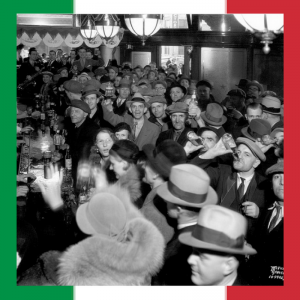 North Beach during Prohibition remained a wide open city. San Francisco officials rejected the idea of enforcing the law against alcohol, allowing its citizen to continue their gin-guzzling ways. The mafia from the East Coast moved in to control the speakeasies and flow of illegal booze. In 1928 a four-year power struggle for control of North Beach resulted in a blood bath that included the deaths of five different Sicilian bosses all of whom had brief reigns in the district. In 1932 at the Del Monte Barber Shop at 720 Columbus Avenue (North Beach Citizens’ headquarters today), Luigi Malvese was gunned down in a hail of bullets with the killer applying the coup de grace behind the ear. The manager of the shop dragged Malvese out to the gutter before returning inside and resuming business.
North Beach during Prohibition remained a wide open city. San Francisco officials rejected the idea of enforcing the law against alcohol, allowing its citizen to continue their gin-guzzling ways. The mafia from the East Coast moved in to control the speakeasies and flow of illegal booze. In 1928 a four-year power struggle for control of North Beach resulted in a blood bath that included the deaths of five different Sicilian bosses all of whom had brief reigns in the district. In 1932 at the Del Monte Barber Shop at 720 Columbus Avenue (North Beach Citizens’ headquarters today), Luigi Malvese was gunned down in a hail of bullets with the killer applying the coup de grace behind the ear. The manager of the shop dragged Malvese out to the gutter before returning inside and resuming business.
The City That Knew How:
The City that knew how was first in both alcohol and gin mills per capita during this period. What later became Mooney’s Irish Pub had a speakeasy in its basement next to a bocce ball court. If there was an unexpected raid, the owner simply changed the color of the curtains on the storefront windows as well as a couple of digits in the street address. In 1933 the Volstead Act was repealed. The bootleg trade dried up and most of the mafia boys left town at the behest of the SFPD.
For more historical tidbits, scroll to the bottom and click on your favorite neighborhood or town. For an inside peek into the award-winning historical fiction novel, Don’t Stop the Music, go to the menu bar at the top and click on “Novels”.
The post North Beach During Prohibition appeared first on John McCarty.
May 8, 2018
Rockin’ the Fillmore
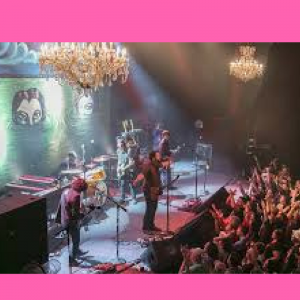 Rockin’ the Fillmore was a pastime for many City kids. Bill Graham pushed hard to establish the Fillmore Auditorium in San Francisco as a respectable concert hall during the 1960s. Downtown was concerned that such an establishment would draw too many kids from the Richmond and Sunset Districts. The potential for further trouble was palpable.
Rockin’ the Fillmore was a pastime for many City kids. Bill Graham pushed hard to establish the Fillmore Auditorium in San Francisco as a respectable concert hall during the 1960s. Downtown was concerned that such an establishment would draw too many kids from the Richmond and Sunset Districts. The potential for further trouble was palpable.
Scruffy bearded young men wore tie-dye headbands while their dates swayed to the music in their heads, their loose fitting blouses drenched in patchouli oil. Bill Graham policed the ticket line at the Fillmore Auditorium himself, manhandling drug dealers and pickpockets. Once inside, you climbed a staircase to a giant room festooned with chandeliers and bands of colored lights. Free apples awaited in a nearby ice bucket while an attendant passed out complimentary posters of that night’s entertainers.
Fillmore Auditorium:
The passageway of the Fillmore Auditorium would be laced with the sweet scent of Mary Jane. Billowing clouds spiraled into the dust-mite air, cardboard-tube bongs standing at attention. Jerry Garcia might be the opening act for Jefferson Airplane while Peter Coyote (movie star later) of the anarchic Diggers would protest the idea of charging money for such heavenly music. Backstage, the house punch would be spiked with Owsley’s acid and the electric Kool-Aid night was officially underway. Owsley Stanley, a.k.a. Bear, was the sound manager for The Grateful Dead and the first individual to mass produce LSD, more than ten million doses between 1965-1967.
For more, scroll to the bottom and click on your favorite neighborhood or town. Bill Graham and the Fillmore Auditorium are featured in Don’t Stop the Music, an award-winning novel. To view more details regarding this historical fiction, go to the top and click on “Novels”.
The post Rockin’ the Fillmore appeared first on John McCarty.
May 6, 2018
North Beach, the Early Days
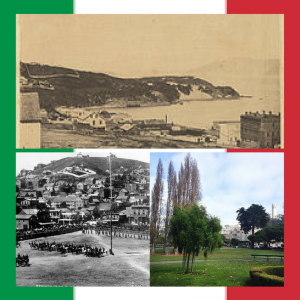 North Beach, the early days, was an actual beach, a landfill dating back to the middle of the 19th century. Warehouses, fishing wharves, and docks were then built on the newly formed shoreline (top photo). Due to the proximity of the docks, the southern half of the neighborhood south of Broadway was home of the infamous Barbary Coast.
North Beach, the early days, was an actual beach, a landfill dating back to the middle of the 19th century. Warehouses, fishing wharves, and docks were then built on the newly formed shoreline (top photo). Due to the proximity of the docks, the southern half of the neighborhood south of Broadway was home of the infamous Barbary Coast.
Washington Square was one of the first parks designated in San Francisco, established in 1847(bottom photos). Grant Avenue is the oldest street in San Francisco. It has had other names prior to becoming “Grant” in 1906 such as the Street of the Founding and Dupont Street. Upper Grant, as the locals refer to it, is the center of many cafes and vintage boutiques including Café Trieste and The Saloon, which date back to 1861.
North Beach Early History:
After the 1906 earthquake and fire, Germans, Russians, Eastern Europeans moved out permanently while Italian migration into the neighborhood continued. The Italian influence on North Beach peaked between the two World Wars when over 60,000 of its residents claimed Italian ancestry and five Italian language newspapers circulated the neighborhood. By the 1920s, North Beach was predominantly Italian and known as “Little Italy,” creating the character of the neighborhood that still exists today.
For more fun tidbits on this district of San Francisco, scroll to the bottom of this page and click on “North Beach”. This area was featured in the historical fiction novel, Stumptown Daze. For reviews, sample chapters and historical photos, click on “Novels” at the top.
The post North Beach, the Early Days appeared first on John McCarty.
May 4, 2018
Fillmore Notables of Old
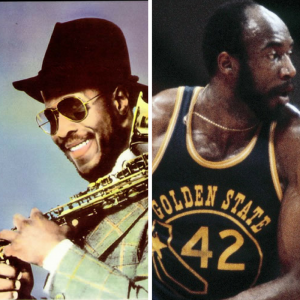 Fillmore notables of old San Francisco included Nate Thurmond and John Handy. Though “Harlem of the West” was on life support in the late sixties, the music prevailed. At Mario Sullivan’s speakeasy (his brother George was the top black music promoter in the West), John Handy played in the backroom of the diner, training other jazz artists to keep the sound alive. His performance at the 1965 Monterey Jazz Festival was recorded and released as an album, which won Grammy nominations for “Spanish Lady” and “If Only We Knew”.
Fillmore notables of old San Francisco included Nate Thurmond and John Handy. Though “Harlem of the West” was on life support in the late sixties, the music prevailed. At Mario Sullivan’s speakeasy (his brother George was the top black music promoter in the West), John Handy played in the backroom of the diner, training other jazz artists to keep the sound alive. His performance at the 1965 Monterey Jazz Festival was recorded and released as an album, which won Grammy nominations for “Spanish Lady” and “If Only We Knew”.
Up the street toward Geary Boulevard it would not be unusual to find Leola King boarding a tour bus, promising a free drink if the passengers took a chance to venture into her Birdcage, a cabaret featuring musicians such as John Handy as well as the best chicken-in-a-basket this side of the Mississippi.
Nate Thurmond:
Another fixture in the Fillmore District of San Francisco was basketball great, Nate Thurmond, driving his Silver Shadow, dressing up the neighborhood. He spent the majority of his fourteen-year NBA career with the Golden State Warriors. He was the first to score an official quadruple-double. In 1965, he grabbed 42 rebounds in a single game and has been named as one of the 50 greatest basketball players of all time. The seven-footer was affectionately called “Nate the Great” by fans. After retirement, he opened a rib joint in the Fillmore, Big Nate’s BBQ. He lived in San Francisco until his passing in 2016 at age 74.
For more, scroll to the bottom and click on your favorite neighborhood or town. The Fillmore District and John Handy appear in the award-winning novel, Don’t Stop the Music. To see further details regarding this historical fiction, go to the top and click on “Novels”.
The post Fillmore Notables of Old appeared first on John McCarty.
May 2, 2018
Gentrification of the Fillmore:
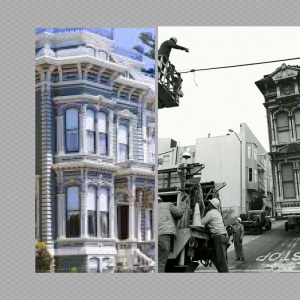 Gentrification of the Fillmore District in San Francisco probably started with the Redevelopment Agency’s wrecking ball in the sixties. Justin Herman was head of the department from 1959 until his death in 1971. Under his administration, thousands of residents, many of them poor and non-white, were forced to abandon their residences and businesses.
Gentrification of the Fillmore District in San Francisco probably started with the Redevelopment Agency’s wrecking ball in the sixties. Justin Herman was head of the department from 1959 until his death in 1971. Under his administration, thousands of residents, many of them poor and non-white, were forced to abandon their residences and businesses.
The Redevelopment Agency ran Geary Boulevard under Fillmore Street so that commuters from the Richmond District could bypass any “trouble’ on their way to their glass cages in the financial district. The wrecking ball found its target on the backsides of some two thousand painted ladies as well. The Victorians were left to rot where they fell. Kids played in the rubble, competing with each other to see who could catch the biggest rodent.
Fillmore Gentrification:
Absentee landlords took advantage of the chaos. In one building, four different families (sixteen persons total) alternated shifts living in a one bedroom apartment, the other three families making do on the streets for a night or two. And there was no toilet. Don’t let the cop catching you pissing in the street. Better do your business at the gas station down the block or else. While the Board of Supervisors has unanimously voted to rename Justin Herman Plaza for a more honorable figure, the gentrification of the Fillmore continues as high-priced restaurants, taverns and hotels force locals out.
For more, scroll to the bottom and click on your favorite neighborhood or town. Also, the underside of the Fillmore is depicted in Don’t Stop the Music, a historical fiction novel that takes place in 1967. If interested, go to the top and click on “Novels” for more details.
The post Gentrification of the Fillmore: appeared first on John McCarty.
April 30, 2018
Irish Ruled San Francisco in the Sixties
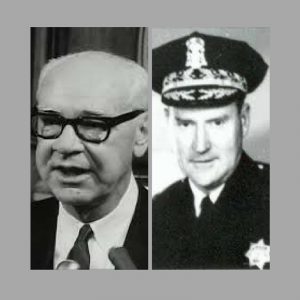 The Irish ruled San Francisco in the sixties. Judge O’Connor was responsible for the juvenile justice system. Tom Cahill was chief of police while Jack Shelley occupied the mayor’s office (see photos). All was as it was apparently meant to be. Until 1966. The mysterious death of George Sullivan, who was the top black music producer on the coast, seemed to trigger an avalanche of racial tension. One hundred and sixty-seven dissidents were arrested for picketing the Sheraton Palace Hotel and their failure to hire blacks. One hundred and eighty civil rights demonstrators were hauled downtown for illegal sit-ins at Wessman Lincoln-Mercury and Cadillac dealerships.
The Irish ruled San Francisco in the sixties. Judge O’Connor was responsible for the juvenile justice system. Tom Cahill was chief of police while Jack Shelley occupied the mayor’s office (see photos). All was as it was apparently meant to be. Until 1966. The mysterious death of George Sullivan, who was the top black music producer on the coast, seemed to trigger an avalanche of racial tension. One hundred and sixty-seven dissidents were arrested for picketing the Sheraton Palace Hotel and their failure to hire blacks. One hundred and eighty civil rights demonstrators were hauled downtown for illegal sit-ins at Wessman Lincoln-Mercury and Cadillac dealerships.
A riot broke out in Hunters Point after a white officer shot and killed a seventeen-year-old African American, Mathew Johnson, as he fled the scene of a stolen car.
Irish Rule:
At a public meeting, the restive crowd was quick to jeer Mayor Shelley while throwing tomatoes at him. That evening on September 27, 1966 sporadic looting and arson broke out. Governor Pat Brown authorized the use of the National Guard and Highway Patrol. Martial Law was imposed on Hunters Point and the Fillmore District. Troops patrolled the streets in jeeps with machine guns mounted on the back. After the riots, the insurance industry refused to underwrite losses incurred by black business owners. Automatic weapons, portable artillery and military occupation offered a vivid demonstration of how far San Francisco Irish officials would go in the attempt to contain black rage. The riots disappeared down the memory hole and few remember it as a meaningful event in the history of San Francisco. Meanwhile, the gentrification of Hunters Point and the Fillmore District continues. At last count, a mere 2,500 African Americans lived in the City.
For more, scroll down and click onto your favorite neighborhood or town. The award-winning novel, Don’t Stop the Music, depicts several scenes in the Fillmore during this era. If interested, go to the top and click on “Novels” and select the above book for more details.
The post Irish Ruled San Francisco in the Sixties appeared first on John McCarty.
April 28, 2018
Guernewood Park: Future’s Past
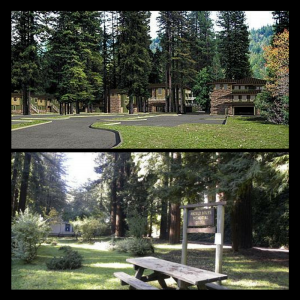 Future’s past of Guernewood Park along the Russian includes a tiny strip of land many of us pass everyday not knowing its significance. It is sandwiched between Highway 116 and Guerneville Lane next to the Guerneville Bible Church. The Angela Boles Memorial Park (bottom photo) celebrates the man who once owned the entire area across the road where a funky restaurant, bar and campground known as Ginger’s Rancho existed. Before that it was the site of the Guernewood Park Hotel, which burned down a long time ago.
Future’s past of Guernewood Park along the Russian includes a tiny strip of land many of us pass everyday not knowing its significance. It is sandwiched between Highway 116 and Guerneville Lane next to the Guerneville Bible Church. The Angela Boles Memorial Park (bottom photo) celebrates the man who once owned the entire area across the road where a funky restaurant, bar and campground known as Ginger’s Rancho existed. Before that it was the site of the Guernewood Park Hotel, which burned down a long time ago.
The existing empty lot next to the Dubrava Village is owned by Kirk Loc who hopes to build a new resort there. The plans call for 100 hotel rooms, 20 housekeeping bungalows, conference rooms, restaurant and a spa (top photo).
Guernewood Park’s Future:
Supporters hope that the new resort will revitalize the region’s economy. The four-story hotel would evoke a traditional rustic lodge appearance and sit just above the beach. The long dormant plan for the resort has been kicked around for the last twenty years, since a previous developer, Paul Wang, built 55 condos before the financing for the project floundered amid the 1980’s savings-and-loan fiasco. The Lok Group operates the Holiday Inn in Sebastopol and the Day’s Inn in Petaluma. An added bonus if the project moves forward would be the reduction of litter, drugs and homeless encampments on the property.
For more on the Russian River or San Francisco, scroll to the bottom of this page and click on your favorite town or neighborhood. Also, don’t forget to explore the award winning novel, Don’t Stop the Music, by clicking on “Novels” at the top.
The post Guernewood Park: Future’s Past appeared first on John McCarty.

